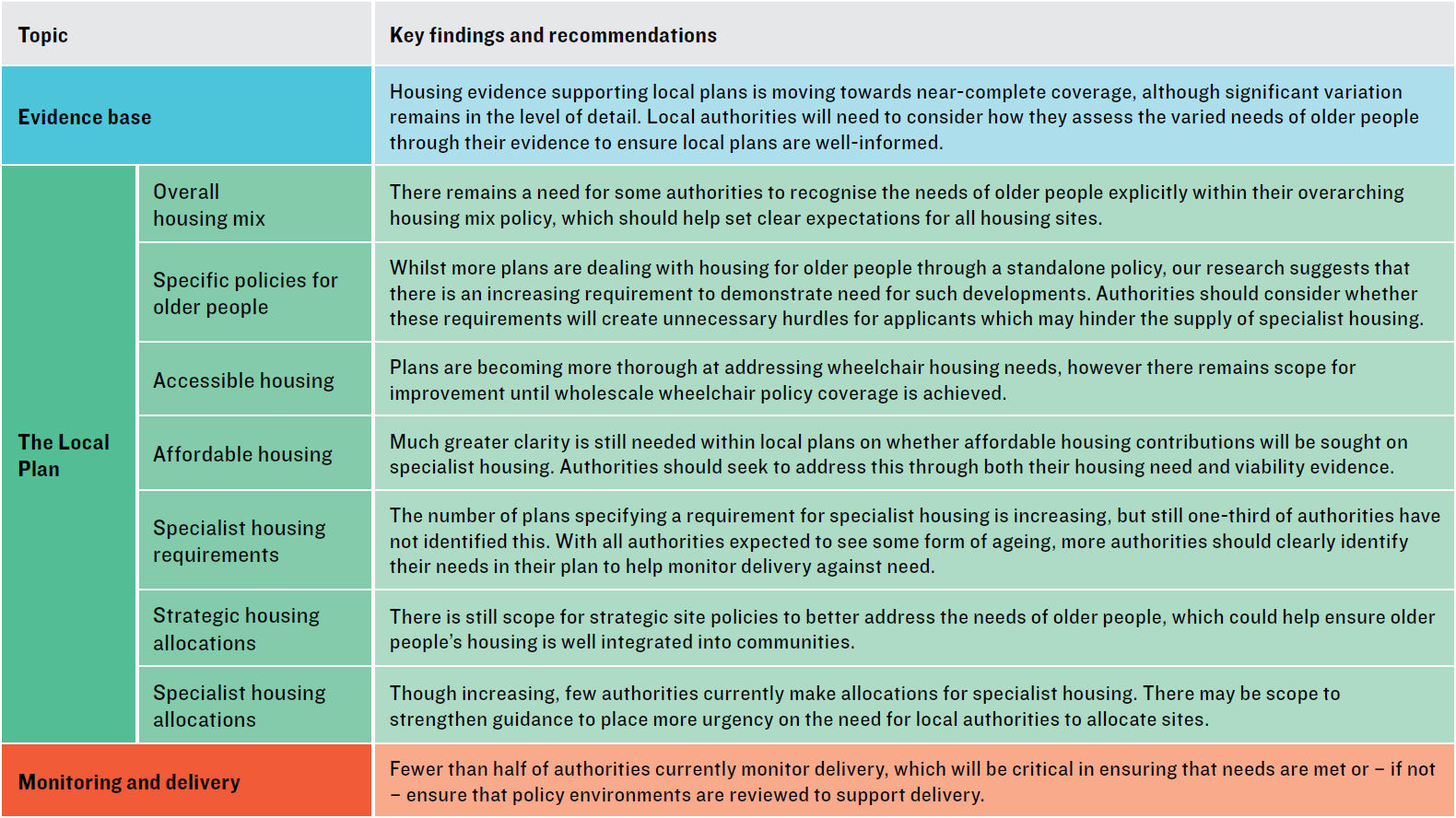It’s certainly not news that as our population ages, the importance of providing suitable housing for older people becomes increasingly crucial, and with over 65s making up 80% of all household growth
[1] it is vital they are given proper consideration when planning for housing and other needs. Five years ago our original research looked at how the planning system was addressing the needs of older people, finding that the vast majority of local plans did not clearly engage with older people’s housing needs. It made a series of recommendations about how this could be improved.
Our
updated research provides a refreshed and more in-depth look at how local plans, both adopted and emerging, address the housing needs of older people, to see what has changed. In short, things are moving in the right direction, but there is still a significant way to go.
This time, we looked at three key parts of the plan-making process:
- Evidence base – our research looked at whether the evidence base for housing included a reference to the needs of older people, and if so whether this referred to care homes;
- Local Plans – our research looked at whether the local plan quantifies the need for older people’s housing, either within a policy or in supporting text, so that the overall scale of need is clearly identified. It also looked at whether the plan’s general policy on housing mix refers to the needs of older people and whether the plan contains a standalone policy addressing the needs of older people (and if it did, whether this includes reference to care homes and whether it requires there to be evidence of need). Recognising the role that accessible housing more generally can play, our research also looked at whether the plan includes a policy requirement for wheelchair accessible housing. In terms of affordable housing, we also looked at whether plans were clear on whether affordable housing contributions for elderly housing are required. Finally, we considered site allocations; firstly, if the plan contains strategic allocations, whether these refer to the needs of older people, and secondly whether the plan contains standalone allocations for housing for older people; and
- Monitoring – our research looked at whether the local authority monitored delivery of housing for older people (for example, in the Annual Monitoring Report) and if so, did this include care homes.
For these, we compared plans adopted
pre-2012 NPPF, plans prepared under the
2012 NPPF, plans prepared under the
2018 NPPF and
emerging [submitted] plans (all of which are being prepared under the 2018 NPPF
[2]), shown in Figure 1 below.
Figure 1 Summary of research findings – percentage of local plan fulfilling assessment criteria based on plan age
By all measures, plans are moving in the right direction, with:
- More authorities assessing needs within their evidence base;
- More plans quantifying need, including standalone policies for older people’s housing, and requiring wheelchair housing; and,
- More reference to older people’s housing in both strategic and standalone allocations.
However, significant progress still needs to be made in order for the planning system nationally to begin delivering the scale of older person’s housing that is likely to be needed, with the evidence base still not fully translating into a suite of policies which would support significant scale specialist housing delivery.
With only 20% of emerging plans making allocations for housing for older people (up from 8% prior to 2012), it could take decades for all (or even the majority of) plans to make allocations for housing for older people. Current guidance sends a somewhat mixed message, stating that it is “
up to the plan-making authority” to make allocations but also that allocating sites “
may be appropriate where there is an identified unmet need for specialist housing”
– which is the case for virtually all authorities, as shown in their evidence base. A significant change in guidance could be necessary to place much greater urgency on the need for allocations and rapidly increase the number of plans making allocations.
Our findings and key recommendations across each of the areas of plan-making are shown in Figure 2.
Figure 2 Key findings and recommendations – Solutions to an age old problem research
Source: Lichfields
Final thoughts
Understanding how older people’s needs are being addressed in plan-making is key to assessing the effectiveness of national policy and guidance, and helping identify areas for future change and improvement. In short, whilst we have found that older people’s housing need almost always now features in the evidence base in plan-making (albeit in varying levels of detail), the way this is fed through into policies in the plan varies considerably, with significant scope for improvement still remaining.
So, are things likely to continue improving in the future? Whilst the 2023 NPPF includes additional references to the types of housing older people may require (retirement housing, housing with care and care homes), the overall thrust of paragraph 63 – to “assess and reflect needs within planning policies” – remains the same as it was in the 2018 NPPF. Although emerging plans that we assessed (prepared under the 2018 NPPF) suggest trends are slowly moving in the right direction, without any change to underlying policy and guidance it is still uncertain whether the 2023 revisions to the NPPF will result in any material shift in how plans address older people’s needs.
The challenge of providing adequate housing for an ageing population is significant but not insurmountable, and the insights and recommendations from our research could lead to substantial improvements in housing provision for our ageing population. By strengthening the evidence base, providing greater clarity and direction within local plan policies, and ensuring effective monitoring, local authorities can better meet the needs of older people, but this must also be met with engagement from other stakeholders. An imminent potential change in government – and potential change in NPPF – could represent an opportunity to bolster older people’s housing needs and make an important contribution to the aim of significantly boosting housing supply in the next five years.
[1] ONS 2018-based Household Projections here (see Table 1)
[2] This is because the transitional arrangements set out in the December 2023 NPPF (para 230) only require the 2023 NPPF to be taken into account for the purposes of plan-making for plans that reach Regulation 19 after March 2024.
[3] Planning Practice Guidance: Housing for older and disabled people Reference ID: 63-013-20190626





